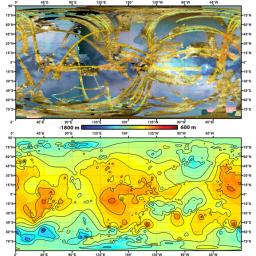
|
Two Views of Titan’s Topography
- Click the image above for a larger view
- Full-Res JPEG (2197 x 2197) (845.1 kB)
- Full-Res TIFF (2197 x 2197) (14.5 MB)
Caption:
To create the first global, topographic map of Saturn's moon Titan, scientists analyzed data from NASA's Cassini spacecraft and a mathematical process called splining. This method effectively uses smooth curved surfaces to "join" the areas between grids of existing topography profiles obtained by Cassini's radar instrument. In the upper panel of this graphic, gold colors show where radar images have been obtained over almost half of Titan's surface. Within the gold areas, narrow strips of rainbow colors show where height data have been obtained. Those data are laid over a blue-toned, near-global map of infrared color from the Cassini visual and infrared mapping spectrometer instrument. The lower panel shows the new topography map, with contour lines added at 656 feet (200 meters) apart in elevation. South polar depressions and four mountains are notably prominent; a dark region at 50 to 65 degrees south latitude and 0 to 60 degrees east longitude coincides with a major depression.
The radar and VIMS data were obtained from 2004 to 2011.
Background Info:
The Cassini-Huygens mission is a cooperative project of NASA, the European Space Agency and ASI, the Italian Space Agency. JPL, a division of the California Institute of Technology in Pasadena, manages the mission for NASA's Science Mission Directorate, Washington. The radar instrument was built by JPL and the Italian Space Agency, working with team members from the US and several European countries.
Cataloging Keywords:
| Name | Value | Additional Values |
|---|---|---|
| Target | Titan | |
| System | Saturn | |
| Target Type | Satellite | |
| Mission | Cassini-Huygens | |
| Instrument Host | Cassini Orbiter | |
| Host Type | Orbiter | |
| Instrument | Radar Mapper | Visual and Infrared Mapping Spectrometer (VIMS) |
| Detector | ||
| Extra Keywords | Color, Infrared, Map, Mountain, Radar, Visual | |
| Acquisition Date | ||
| Release Date | 2013-05-15 | |
| Date in Caption | ||
| Image Credit | NASA/JPL-Caltech/ASI/JHUAPL/Cornell/Weizmann | |
| Source | photojournal.jpl.nasa.gov/catalog/PIA16849 | |
| Identifier | PIA16849 | |
